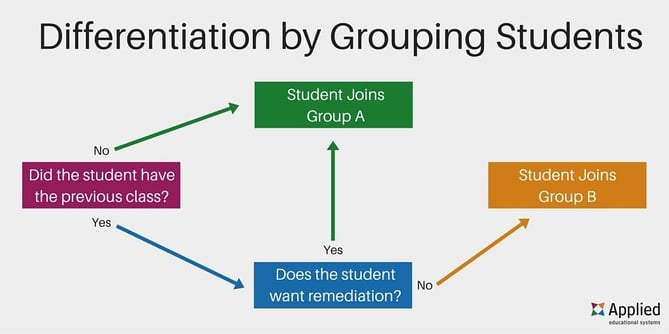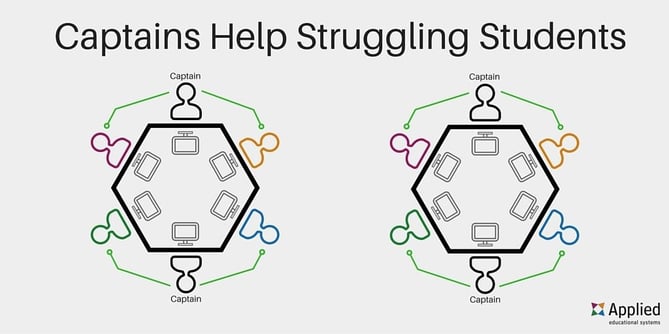Computer Applications | Differentiated Instruction | Teaching Strategies
3 Easy Ways to Include Differentiated Lesson Plans in Computer Classes
Frank DiMaria is a middle school computer teacher in Fort Mill, SC. Frank has written an number of guest articles for AES to help other teachers be more effective in the classroom.
Note from Bri: This is a guest post from Frank DiMaria, a middle school computer teacher in Fort Mill, SC. Frank has written a number of articles about educational technology and tips for other teachers.
At AES when talking to computer teachers, we are often asked about ways to differentiate instruction. In hopes of providing information to these teachers, we asked Frank to share some ways he differentiates his computer lessons.
Do you struggle to include differentiated lesson plans in your computer classes? I find that those of us who teach electives in middle school encounter students of varying skill levels within a single class. I know what you’re thinking: “All teachers face that.” True. But rarely does an Algebra II teacher walk into a classroom to teach students who have yet to take Algebra I.
Each semester I must teach eighth grade students who did not take my class as seventh or sixth graders. Needless to say these students don’t bring the same computer knowledge and skill set to my class as those who previously had my class for two full years.
To ensure that all students, no matter their skill level, succeed and are challenged in my class I employ several procedural and instructional design strategies. These differentiated instruction strategies allow me to manage my expectations, as well as the expectations of my students.
Tip 1 - What Group Are You In?
Before I begin a new unit I tell my students what skills they need in order to complete the assignments in the unit, the end items they’ll turn in for a grade, and the software they’ll use to complete the assignments. Based on this information I ask them to separate into two groups: A and B
Group A is comprised of students who did not take my class the previous year and Group B has those who did. Students who had my class the previous year, but feel they need some remediation are welcome to join Group A. In most cases these students progress to Group B once they regain their confidence.

Now in their groups my students begin working. Let’s say the first assignment in the unit is to design a magazine cover using graphic design software, like Photoshop or GIMP. I instruct Group A to put their headphones on and view a video tutorial I created using SMART Recorder. The video features a lesson from the previous year and teaches the most basic skills they need to complete the assignments in the unit. Once they view the video, I provide them with the electronic files, handouts, rubrics, and models they need to complete the assignment I featured in the tutorial.
While Group A is viewing the video tutorial, on the other side of the classroom I present Group B with the first lesson of the new unit. Because I’ve created SMART video tutorials of all the lessons I teach, I can reverse this process as necessary. If Group A needs “live” instruction, I have Group B view the tutorial for the new lesson while I get Group A up to speed.
Tip 2 - Oh Captain, My Captain!
Grouping students is a key aspect of including differentiated lesson plans in a middle school technology class. But I don’t always separate the most skilled students from the least skilled students. Over the years I’ve observed that students learn exceptionally well from their peers, and I’ve devised a system that exploits this.
The computers in my lab are arranged in five pods of six computers each. Rather than sitting in rows shoulder to shoulder, my students sit in groups of six in a circular configuration, encouraging student interaction.
Depending on the lesson and the skill level of the students in a particular class, I sometimes assign two “Captains” to each six-student pod. Captains are students who had my class the previous year and demonstrated the ability to acquire skills quickly and possess the demeanor to assist other students. I fill in the other four seats at the pod with students who didn’t have my class the previous year and with those who do not acquire skills as rapidly as others.

I tell the students that they are allowed to seek the assistance of a Captain at their pod whenever they can’t accomplish a task or need to have a concept clarified. Without getting out of their seats my captains can assist the student to right and to the left of them.
For the most part Captains are willing to share their expertise with their peers and they get a sense of accomplishment when they assist struggling students. Struggling students are typically thankful to have someone who can assist them immediately, rather than waiting for me as I make my rounds.
Tip 3 - Eliminate Tears with Tiers
To ensure that I challenge those students who bring the highest software skills to my class, while also ensuring success for those who don’t, I tier my units.
For example, I teach a unit in which my students learn the basics of owning a small business. In this unit they must:
- Design a Commercial Website
- Create a Merchandise Order using Excel
- Create a Detailed Yearly Sales Report in Excel
My expectation is that students with average computer skills will be able to complete the Website and the Merchandise Order with guidance from me. However, I expect only those students with the highest-level skills in Microsoft Excel to complete the Sales Report.
Again I use the video tutorials I created to ensure continuity in the unit. When my students complete lesson one, they get a handout, rubric, and a model for lesson two and watch the video tutorial detailing that lesson. When they are done watching the tutorial they start lesson two. Students follow this procedure until they complete all the lessons in the unit. After the second unit of the semester, my students are so accustomed to the process they move from lesson to lesson with ease, working at their own pace.
Including Differentiated Lesson Plans is Well Worth It!
Not every student comes to your computer class with the skills necessary to complete every assignment. But if you differentiate computer lessons in a way that makes sense to you, keep the students’ best interests in mind, and if you’re willing to exempt students from assignments they don’t have the skills to complete, you and your students will enjoy success in your computer class.


